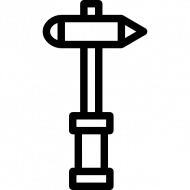Durante los últimos años las mutaciones “de novo”, aquellas no heredadas de ninguno de los dos progenitores, han cobrado especial relevancia en neurología pediátrica, por varios motivos:
Son responsables de la mayor parte de los casos de trastornos del neurodesarrollo identificables genéticamente.
Son responsables de los casos de mayor gravedad.
Esto se explica porque existe sesgo por selección natural. Las enfermedades heredadas suelen tener menor gravedad que las enfermedades “de novo”, porque implican que el indivíduo ha sido capaz de vivir hasta la edad adulta, emparejase y reproducirse. De esta forma, las variantes que permanecen en la población general, y son encontradas con frecuencia en portadores sanos, producen menor repercusión fenotípica, aunque que una variante sea “de novo” no garantiza la patogenicidad.
Accordion title 1
This is a placeholder tab content. It is important to have the necessary information in the block, but at this stage, it is just a placeholder to help you visualise how the content is displayed. Feel free to edit this with your actual content.
Accordion title 2
This is a placeholder tab content. It is important to have the necessary information in the block, but at this stage, it is just a placeholder to help you visualise how the content is displayed. Feel free to edit this with your actual content.
Cuestionan el paradigma clásico de enfermedad genética como enfermedad heredada.
Esto pone en cuestión la importancia relativa de los antecedentes familiares a la hora de sospechar una enfermedad genética, ya que su ausencia no es criterio de exclusión.
A través de los estudios genómicos, somos conocedores actualmente de que las personas sanas son portadoras de alrededor de unas 50-100 mutaciones de novo.
Por lo tanto, no es infrecuente que existan casos de fenotipo complejo en los que múltiples mutaciones dan lugar a fenotipos superpuestos de mayor gravedad (
double trouble ), dando lugar al concepto de “carga mutacional”.
Esto cuestiona el paradigma clásico de enfermedad monogenética.
De esta forma, el papel de las variantes genéticas que cada indivíduo presenta puede representar una herencia poligénica (cuantitativa, factor de riesgo) cuando las variantes producen poca repercusión fenotípica, o una enfermedad monogenética, cuando la localización y consecuencias de la variante produce una repercusión clínica grave.
332710
{332710:B94ZA2AN},{332710:PVKWWRXJ},{332710:5LKWXN5E},{332710:5NYIBBYH},{332710:D55UI4BK}
vancouver
50
6153
https://neuropediatoolkit.org/wp-content/plugins/zotpress/
%7B%22status%22%3A%22success%22%2C%22updateneeded%22%3Afalse%2C%22instance%22%3A%22zotpress-87e8307cfcf612d7b57928c9815b6b32%22%2C%22meta%22%3A%7B%22request_last%22%3A0%2C%22request_next%22%3A0%2C%22used_cache%22%3Atrue%7D%2C%22data%22%3A%5B%7B%22key%22%3A%225LKWXN5E%22%2C%22library%22%3A%7B%22id%22%3A332710%7D%2C%22meta%22%3A%7B%22creatorSummary%22%3A%22Goldmann%20et%20al.%22%2C%22parsedDate%22%3A%222019-11-01%22%2C%22numChildren%22%3A2%7D%2C%22bib%22%3A%22%3Cdiv%20class%3D%5C%22csl-bib-body%5C%22%20style%3D%5C%22line-height%3A%201.35%3B%20%5C%22%3E%5Cn%20%20%3Cdiv%20class%3D%5C%22csl-entry%5C%22%20style%3D%5C%22clear%3A%20left%3B%20%5C%22%3E%5Cn%20%20%20%20%3Cdiv%20class%3D%5C%22csl-left-margin%5C%22%20style%3D%5C%22float%3A%20left%3B%20padding-right%3A%200.5em%3B%20text-align%3A%20right%3B%20width%3A%201em%3B%5C%22%3E1.%3C%5C%2Fdiv%3E%3Cdiv%20class%3D%5C%22csl-right-inline%5C%22%20style%3D%5C%22margin%3A%200%20.4em%200%201.5em%3B%5C%22%3EGoldmann%20JM%2C%20Veltman%20JA%2C%20Gilissen%20C.%20De%20Novo%20Mutations%20Reflect%20Development%20and%20Aging%20of%20the%20Human%20Germline.%20Trends%20in%20Genetics%20%5BInternet%5D.%202019%20Nov%201%20%5Bcited%202023%20Mar%205%5D%3B35%2811%29%3A828%26%23x2013%3B39.%20Available%20from%3A%20%3Ca%20href%3D%27https%3A%5C%2F%5C%2Fwww.cell.com%5C%2Ftrends%5C%2Fgenetics%5C%2Fabstract%5C%2FS0168-9525%2819%2930178-7%27%3Ehttps%3A%5C%2F%5C%2Fwww.cell.com%5C%2Ftrends%5C%2Fgenetics%5C%2Fabstract%5C%2FS0168-9525%2819%2930178-7%3C%5C%2Fa%3E%3C%5C%2Fdiv%3E%5Cn%20%20%3C%5C%2Fdiv%3E%5Cn%3C%5C%2Fdiv%3E%22%2C%22data%22%3A%7B%22itemType%22%3A%22journalArticle%22%2C%22title%22%3A%22De%20Novo%20Mutations%20Reflect%20Development%20and%20Aging%20of%20the%20Human%20Germline%22%2C%22creators%22%3A%5B%7B%22creatorType%22%3A%22author%22%2C%22firstName%22%3A%22J.%20M.%22%2C%22lastName%22%3A%22Goldmann%22%7D%2C%7B%22creatorType%22%3A%22author%22%2C%22firstName%22%3A%22J.%20A.%22%2C%22lastName%22%3A%22Veltman%22%7D%2C%7B%22creatorType%22%3A%22author%22%2C%22firstName%22%3A%22C.%22%2C%22lastName%22%3A%22Gilissen%22%7D%5D%2C%22abstractNote%22%3A%22%22%2C%22date%22%3A%222019-11-01%22%2C%22language%22%3A%22English%22%2C%22DOI%22%3A%2210.1016%5C%2Fj.tig.2019.08.005%22%2C%22ISSN%22%3A%220168-9525%22%2C%22url%22%3A%22https%3A%5C%2F%5C%2Fwww.cell.com%5C%2Ftrends%5C%2Fgenetics%5C%2Fabstract%5C%2FS0168-9525%2819%2930178-7%22%2C%22collections%22%3A%5B%22P73EKVEL%22%5D%2C%22dateModified%22%3A%222023-03-05T08%3A47%3A44Z%22%7D%7D%2C%7B%22key%22%3A%225NYIBBYH%22%2C%22library%22%3A%7B%22id%22%3A332710%7D%2C%22meta%22%3A%7B%22creatorSummary%22%3A%22Posey%20et%20al.%22%2C%22parsedDate%22%3A%222017-01-05%22%2C%22numChildren%22%3A2%7D%2C%22bib%22%3A%22%3Cdiv%20class%3D%5C%22csl-bib-body%5C%22%20style%3D%5C%22line-height%3A%201.35%3B%20%5C%22%3E%5Cn%20%20%3Cdiv%20class%3D%5C%22csl-entry%5C%22%20style%3D%5C%22clear%3A%20left%3B%20%5C%22%3E%5Cn%20%20%20%20%3Cdiv%20class%3D%5C%22csl-left-margin%5C%22%20style%3D%5C%22float%3A%20left%3B%20padding-right%3A%200.5em%3B%20text-align%3A%20right%3B%20width%3A%201em%3B%5C%22%3E1.%3C%5C%2Fdiv%3E%3Cdiv%20class%3D%5C%22csl-right-inline%5C%22%20style%3D%5C%22margin%3A%200%20.4em%200%201.5em%3B%5C%22%3EPosey%20JE%2C%20Harel%20T%2C%20Liu%20P%2C%20Rosenfeld%20JA%2C%20James%20RA%2C%20Coban%20Akdemir%20ZH%2C%20et%20al.%20Resolution%20of%20Disease%20Phenotypes%20Resulting%20from%20Multilocus%20Genomic%20Variation.%20N%20Engl%20J%20Med%20%5BInternet%5D.%202017%20Jan%205%20%5Bcited%202022%20Mar%203%5D%3B376%281%29%3A21%26%23x2013%3B31.%20Available%20from%3A%20%3Ca%20href%3D%27http%3A%5C%2F%5C%2Fwww.nejm.org%5C%2Fdoi%5C%2F10.1056%5C%2FNEJMoa1516767%27%3Ehttp%3A%5C%2F%5C%2Fwww.nejm.org%5C%2Fdoi%5C%2F10.1056%5C%2FNEJMoa1516767%3C%5C%2Fa%3E%3C%5C%2Fdiv%3E%5Cn%20%20%3C%5C%2Fdiv%3E%5Cn%3C%5C%2Fdiv%3E%22%2C%22data%22%3A%7B%22itemType%22%3A%22journalArticle%22%2C%22title%22%3A%22Resolution%20of%20Disease%20Phenotypes%20Resulting%20from%20Multilocus%20Genomic%20Variation%22%2C%22creators%22%3A%5B%7B%22creatorType%22%3A%22author%22%2C%22firstName%22%3A%22Jennifer%20E.%22%2C%22lastName%22%3A%22Posey%22%7D%2C%7B%22creatorType%22%3A%22author%22%2C%22firstName%22%3A%22Tamar%22%2C%22lastName%22%3A%22Harel%22%7D%2C%7B%22creatorType%22%3A%22author%22%2C%22firstName%22%3A%22Pengfei%22%2C%22lastName%22%3A%22Liu%22%7D%2C%7B%22creatorType%22%3A%22author%22%2C%22firstName%22%3A%22Jill%20A.%22%2C%22lastName%22%3A%22Rosenfeld%22%7D%2C%7B%22creatorType%22%3A%22author%22%2C%22firstName%22%3A%22Regis%20A.%22%2C%22lastName%22%3A%22James%22%7D%2C%7B%22creatorType%22%3A%22author%22%2C%22firstName%22%3A%22Zeynep%20H.%22%2C%22lastName%22%3A%22Coban%20Akdemir%22%7D%2C%7B%22creatorType%22%3A%22author%22%2C%22firstName%22%3A%22Magdalena%22%2C%22lastName%22%3A%22Walkiewicz%22%7D%2C%7B%22creatorType%22%3A%22author%22%2C%22firstName%22%3A%22Weimin%22%2C%22lastName%22%3A%22Bi%22%7D%2C%7B%22creatorType%22%3A%22author%22%2C%22firstName%22%3A%22Rui%22%2C%22lastName%22%3A%22Xiao%22%7D%2C%7B%22creatorType%22%3A%22author%22%2C%22firstName%22%3A%22Yan%22%2C%22lastName%22%3A%22Ding%22%7D%2C%7B%22creatorType%22%3A%22author%22%2C%22firstName%22%3A%22Fan%22%2C%22lastName%22%3A%22Xia%22%7D%2C%7B%22creatorType%22%3A%22author%22%2C%22firstName%22%3A%22Arthur%20L.%22%2C%22lastName%22%3A%22Beaudet%22%7D%2C%7B%22creatorType%22%3A%22author%22%2C%22firstName%22%3A%22Donna%20M.%22%2C%22lastName%22%3A%22Muzny%22%7D%2C%7B%22creatorType%22%3A%22author%22%2C%22firstName%22%3A%22Richard%20A.%22%2C%22lastName%22%3A%22Gibbs%22%7D%2C%7B%22creatorType%22%3A%22author%22%2C%22firstName%22%3A%22Eric%22%2C%22lastName%22%3A%22Boerwinkle%22%7D%2C%7B%22creatorType%22%3A%22author%22%2C%22firstName%22%3A%22Christine%20M.%22%2C%22lastName%22%3A%22Eng%22%7D%2C%7B%22creatorType%22%3A%22author%22%2C%22firstName%22%3A%22V.%20Reid%22%2C%22lastName%22%3A%22Sutton%22%7D%2C%7B%22creatorType%22%3A%22author%22%2C%22firstName%22%3A%22Chad%20A.%22%2C%22lastName%22%3A%22Shaw%22%7D%2C%7B%22creatorType%22%3A%22author%22%2C%22firstName%22%3A%22Sharon%20E.%22%2C%22lastName%22%3A%22Plon%22%7D%2C%7B%22creatorType%22%3A%22author%22%2C%22firstName%22%3A%22Yaping%22%2C%22lastName%22%3A%22Yang%22%7D%2C%7B%22creatorType%22%3A%22author%22%2C%22firstName%22%3A%22James%20R.%22%2C%22lastName%22%3A%22Lupski%22%7D%5D%2C%22abstractNote%22%3A%22BACKGROUND%20Whole-exome%20sequencing%20can%20provide%20insight%20into%20the%20relationship%20between%20observed%20clinical%20phenotypes%20and%20underlying%20genotypes.%5CnMETHODS%20We%20conducted%20a%20retrospective%20analysis%20of%20data%20from%20a%20series%20of%207374%20consecutive%20unrelated%20patients%20who%20had%20been%20referred%20to%20a%20clinical%20diagnostic%20laboratory%20for%20whole-exome%20sequencing%3B%20our%20goal%20was%20to%20determine%20the%20frequency%20and%20clinical%20characteristics%20of%20patients%20for%20whom%20more%20than%20one%20molecular%20diagnosis%20was%20reported.%20The%20phenotypic%20similarity%20between%20molecularly%20diagnosed%20pairs%20of%20diseases%20was%20calculated%20with%20the%20use%20of%20terms%20from%20the%20Human%20Phenotype%20Ontology.%5CnRESULTS%20A%20molecular%20diagnosis%20was%20rendered%20for%202076%20of%207374%20patients%20%2828.2%25%29%3B%20among%20these%20patients%2C%20101%20%284.9%25%29%20had%20diagnoses%20that%20involved%20two%20or%20more%20disease%20loci.%20We%20also%20analyzed%20parental%20samples%2C%20when%20available%2C%20and%20found%20that%20de%20novo%20variants%20accounted%20for%2067.8%25%20%2861%20of%2090%29%20of%20pathogenic%20variants%20in%20autosomal%20dominant%20disease%20genes%20and%2051.7%25%20%2815%20of%2029%29%20of%20pathogenic%20variants%20in%20X-linked%20disease%20genes%3B%20both%20variants%20were%20de%20novo%20in%2044.7%25%20%2817%20of%2038%29%20of%20patients%20with%20two%20monoallelic%20variants.%20Causal%20copy-number%20variants%20were%20found%20in%2012%20patients%20%2811.9%25%29%20with%20multiple%20diagnoses.%20Phenotypic%20similarity%20scores%20were%20significantly%20lower%20among%20patients%20in%20whom%20the%20phenotype%20resulted%20from%20two%20distinct%20mendelian%20disorders%20that%20affected%20different%20organ%20systems%20%2850%20patients%29%20than%20among%20patients%20with%20disorders%20that%20had%20overlapping%20phenotypic%20features%20%2830%20patients%29%20%28median%20score%2C%200.21%20vs.%200.36%3B%20P%5Cu2009%3D%5Cu20091.77%5Cu00d710%5Cu22127%29.%20From%20the%20Departments%20of%20Molecular%20and%20Human%20Genetics%20%28J.E.P.%2C%20T.H.%2C%20P.L.%2C%20J.A.R.%2C%20Z.H.C.A.%2C%20M.W.%2C%20W.B.%2C%20R.X.%2C%20F.X.%2C%20A.L.B.%2C%20D.M.M.%2C%20R.A.G.%2C%20C.M.E.%2C%20V.R.S.%2C%20C.A.S.%2C%20S.E.P.%2C%20Y.Y.%2C%20J.R.L.%29%20and%20Pediatrics%20%28S.E.P.%2C%20J.R.L.%29%2C%20Baylor%20Genetics%20%28P.L.%2C%20M.W.%2C%20W.B.%2C%20R.X.%2C%20Y.D.%2C%20F.X.%2C%20R.A.G.%2C%20C.M.E.%2C%20Y.Y.%29%2C%20Program%20in%20Structural%20and%20Computational%20Biology%20and%20Molecular%20Biophysics%20%28R.A.J.%29%2C%20and%20Human%20Genome%20Sequencing%20Center%20%28D.M.M.%2C%20R.A.G.%2C%20E.B.%2C%20S.E.P.%2C%20J.R.L.%29%2C%20Baylor%20College%20of%20Medicine%2C%20the%20Human%20Genetics%20Center%2C%20University%20of%20Texas%20Health%20Science%20Center%20%28E.B.%29%2C%20and%20the%20Department%20of%20Pediatrics%20%28S.E.P.%2C%20J.R.L.%29%20and%20Texas%20Children%5Cu2019s%20Cancer%20Center%20%28S.E.P.%29%2C%20Texas%20Children%5Cu2019s%20Hospital%20%5Cu2014all%20in%20Houston.%20Address%20reprint%20requests%20to%20Dr.%20Posey%20or%20Dr.%20Lupski%20at%20the%20Baylor%20College%20of%20Medicine%2C%201%20Baylor%20Plaza%2C%20Rm.%20604B%2C%20Houston%2C%20TX%2077030%2C%20or%20at%20%5Cu00adjennifer%20.%5Cu00adposey%40%5Cu00adbcm.%5Cu00adedu%20or%20%5Cu00adjlupski%40%5Cu00adbcm.%5Cu00adedu.%20Drs.%20Posey%20and%20Harel%20contributed%20equally%20to%20this%20article.%20This%20article%20was%20published%20on%20December%207%2C%202016%2C%20at%20NEJM.org.%20N%20Engl%20J%20Med%202017%3B376%3A21-31.%20DOI%3A%2010.1056%5C%2FNEJMoa1516767%20Copyright%20%5Cu00a9%202016%20Massachusetts%20Medical%20Society.%5CnCONCLUSIONS%20In%20our%20study%2C%20we%20found%20multiple%20molecular%20diagnoses%20in%204.9%25%20of%20cases%20in%20which%20whole-exome%20sequencing%20was%20informative.%20Our%20results%20show%20that%20structured%20clinical%20ontologies%20can%20be%20used%20to%20determine%20the%20degree%20of%20overlap%20between%20two%20mendelian%20diseases%20in%20the%20same%20patient%3B%20the%20diseases%20can%20be%20distinct%20or%20overlapping.%20Distinct%20disease%20phenotypes%20affect%20different%20organ%20systems%2C%20whereas%20overlapping%20disease%20phenotypes%20are%20more%20likely%20to%20be%20caused%20by%20two%20genes%20encoding%20proteins%20that%20interact%20within%20the%20same%20pathway.%20%28Funded%20by%20the%20National%20Institutes%20of%20Health%20and%20the%20Ting%20Tsung%20and%20Wei%20Fong%20Chao%20Foundation.%29%22%2C%22date%22%3A%222017-01-05%22%2C%22language%22%3A%22en%22%2C%22DOI%22%3A%2210.1056%5C%2FNEJMoa1516767%22%2C%22ISSN%22%3A%220028-4793%2C%201533-4406%22%2C%22url%22%3A%22http%3A%5C%2F%5C%2Fwww.nejm.org%5C%2Fdoi%5C%2F10.1056%5C%2FNEJMoa1516767%22%2C%22collections%22%3A%5B%22N2ARV9VB%22%2C%22KEFKEWSD%22%5D%2C%22dateModified%22%3A%222023-02-20T18%3A49%3A41Z%22%7D%7D%2C%7B%22key%22%3A%22PVKWWRXJ%22%2C%22library%22%3A%7B%22id%22%3A332710%7D%2C%22meta%22%3A%7B%22creatorSummary%22%3A%22Parenti%20et%20al.%22%2C%22parsedDate%22%3A%222020-08-01%22%2C%22numChildren%22%3A2%7D%2C%22bib%22%3A%22%3Cdiv%20class%3D%5C%22csl-bib-body%5C%22%20style%3D%5C%22line-height%3A%201.35%3B%20%5C%22%3E%5Cn%20%20%3Cdiv%20class%3D%5C%22csl-entry%5C%22%20style%3D%5C%22clear%3A%20left%3B%20%5C%22%3E%5Cn%20%20%20%20%3Cdiv%20class%3D%5C%22csl-left-margin%5C%22%20style%3D%5C%22float%3A%20left%3B%20padding-right%3A%200.5em%3B%20text-align%3A%20right%3B%20width%3A%201em%3B%5C%22%3E1.%3C%5C%2Fdiv%3E%3Cdiv%20class%3D%5C%22csl-right-inline%5C%22%20style%3D%5C%22margin%3A%200%20.4em%200%201.5em%3B%5C%22%3EParenti%20I%2C%20Rabaneda%20LG%2C%20Schoen%20H%2C%20Novarino%20G.%20Neurodevelopmental%20Disorders%3A%20From%20Genetics%20to%20Functional%20Pathways.%20Trends%20in%20Neurosciences%20%5BInternet%5D.%202020%20Aug%201%20%5Bcited%202021%20May%2019%5D%3B43%288%29%3A608%26%23x2013%3B21.%20Available%20from%3A%20%3Ca%20href%3D%27https%3A%5C%2F%5C%2Fwww.cell.com%5C%2Ftrends%5C%2Fneurosciences%5C%2Fabstract%5C%2FS0166-2236%2820%2930122-3%27%3Ehttps%3A%5C%2F%5C%2Fwww.cell.com%5C%2Ftrends%5C%2Fneurosciences%5C%2Fabstract%5C%2FS0166-2236%2820%2930122-3%3C%5C%2Fa%3E%3C%5C%2Fdiv%3E%5Cn%20%20%3C%5C%2Fdiv%3E%5Cn%3C%5C%2Fdiv%3E%22%2C%22data%22%3A%7B%22itemType%22%3A%22journalArticle%22%2C%22title%22%3A%22Neurodevelopmental%20Disorders%3A%20From%20Genetics%20to%20Functional%20Pathways%22%2C%22creators%22%3A%5B%7B%22creatorType%22%3A%22author%22%2C%22firstName%22%3A%22Ilaria%22%2C%22lastName%22%3A%22Parenti%22%7D%2C%7B%22creatorType%22%3A%22author%22%2C%22firstName%22%3A%22Luis%20G.%22%2C%22lastName%22%3A%22Rabaneda%22%7D%2C%7B%22creatorType%22%3A%22author%22%2C%22firstName%22%3A%22Hanna%22%2C%22lastName%22%3A%22Schoen%22%7D%2C%7B%22creatorType%22%3A%22author%22%2C%22firstName%22%3A%22Gaia%22%2C%22lastName%22%3A%22Novarino%22%7D%5D%2C%22abstractNote%22%3A%22%22%2C%22date%22%3A%222020-08-01%22%2C%22language%22%3A%22English%22%2C%22DOI%22%3A%2210.1016%5C%2Fj.tins.2020.05.004%22%2C%22ISSN%22%3A%220166-2236%2C%201878-108X%22%2C%22url%22%3A%22https%3A%5C%2F%5C%2Fwww.cell.com%5C%2Ftrends%5C%2Fneurosciences%5C%2Fabstract%5C%2FS0166-2236%2820%2930122-3%22%2C%22collections%22%3A%5B%22N2ARV9VB%22%2C%22P73EKVEL%22%5D%2C%22dateModified%22%3A%222023-02-20T18%3A49%3A29Z%22%7D%7D%2C%7B%22key%22%3A%22B94ZA2AN%22%2C%22library%22%3A%7B%22id%22%3A332710%7D%2C%22meta%22%3A%7B%22creatorSummary%22%3A%22Brunet%20et%20al.%22%2C%22parsedDate%22%3A%222021%22%2C%22numChildren%22%3A1%7D%2C%22bib%22%3A%22%3Cdiv%20class%3D%5C%22csl-bib-body%5C%22%20style%3D%5C%22line-height%3A%201.35%3B%20%5C%22%3E%5Cn%20%20%3Cdiv%20class%3D%5C%22csl-entry%5C%22%20style%3D%5C%22clear%3A%20left%3B%20%5C%22%3E%5Cn%20%20%20%20%3Cdiv%20class%3D%5C%22csl-left-margin%5C%22%20style%3D%5C%22float%3A%20left%3B%20padding-right%3A%200.5em%3B%20text-align%3A%20right%3B%20width%3A%201em%3B%5C%22%3E1.%3C%5C%2Fdiv%3E%3Cdiv%20class%3D%5C%22csl-right-inline%5C%22%20style%3D%5C%22margin%3A%200%20.4em%200%201.5em%3B%5C%22%3EBrunet%20T%2C%20Jech%20R%2C%20Brugger%20M%2C%20Kovacs%20R%2C%20Alhaddad%20B%2C%20Leszinski%20G%2C%20et%20al.%20De%20novo%20variants%20in%20neurodevelopmental%20disorders%26%23x2014%3Bexperiences%20from%20a%20tertiary%20care%20center.%20Clinical%20Genetics%20%5BInternet%5D.%202021%20%5Bcited%202023%20Jan%2030%5D%3B100%281%29%3A14%26%23x2013%3B28.%20Available%20from%3A%20%3Ca%20href%3D%27https%3A%5C%2F%5C%2Fonlinelibrary.wiley.com%5C%2Fdoi%5C%2Fabs%5C%2F10.1111%5C%2Fcge.13946%27%3Ehttps%3A%5C%2F%5C%2Fonlinelibrary.wiley.com%5C%2Fdoi%5C%2Fabs%5C%2F10.1111%5C%2Fcge.13946%3C%5C%2Fa%3E%3C%5C%2Fdiv%3E%5Cn%20%20%3C%5C%2Fdiv%3E%5Cn%3C%5C%2Fdiv%3E%22%2C%22data%22%3A%7B%22itemType%22%3A%22journalArticle%22%2C%22title%22%3A%22De%20novo%20variants%20in%20neurodevelopmental%20disorders%5Cu2014experiences%20from%20a%20tertiary%20care%20center%22%2C%22creators%22%3A%5B%7B%22creatorType%22%3A%22author%22%2C%22firstName%22%3A%22Theresa%22%2C%22lastName%22%3A%22Brunet%22%7D%2C%7B%22creatorType%22%3A%22author%22%2C%22firstName%22%3A%22Robert%22%2C%22lastName%22%3A%22Jech%22%7D%2C%7B%22creatorType%22%3A%22author%22%2C%22firstName%22%3A%22Melanie%22%2C%22lastName%22%3A%22Brugger%22%7D%2C%7B%22creatorType%22%3A%22author%22%2C%22firstName%22%3A%22Reka%22%2C%22lastName%22%3A%22Kovacs%22%7D%2C%7B%22creatorType%22%3A%22author%22%2C%22firstName%22%3A%22Bader%22%2C%22lastName%22%3A%22Alhaddad%22%7D%2C%7B%22creatorType%22%3A%22author%22%2C%22firstName%22%3A%22Gloria%22%2C%22lastName%22%3A%22Leszinski%22%7D%2C%7B%22creatorType%22%3A%22author%22%2C%22firstName%22%3A%22Korbinian%20M.%22%2C%22lastName%22%3A%22Riedhammer%22%7D%2C%7B%22creatorType%22%3A%22author%22%2C%22firstName%22%3A%22Dominik%20S.%22%2C%22lastName%22%3A%22Westphal%22%7D%2C%7B%22creatorType%22%3A%22author%22%2C%22firstName%22%3A%22Isabella%22%2C%22lastName%22%3A%22Mahle%22%7D%2C%7B%22creatorType%22%3A%22author%22%2C%22firstName%22%3A%22Katharina%22%2C%22lastName%22%3A%22Mayerhanser%22%7D%2C%7B%22creatorType%22%3A%22author%22%2C%22firstName%22%3A%22Matej%22%2C%22lastName%22%3A%22Skorvanek%22%7D%2C%7B%22creatorType%22%3A%22author%22%2C%22firstName%22%3A%22Sandrina%22%2C%22lastName%22%3A%22Weber%22%7D%2C%7B%22creatorType%22%3A%22author%22%2C%22firstName%22%3A%22Elisabeth%22%2C%22lastName%22%3A%22Graf%22%7D%2C%7B%22creatorType%22%3A%22author%22%2C%22firstName%22%3A%22Riccardo%22%2C%22lastName%22%3A%22Berutti%22%7D%2C%7B%22creatorType%22%3A%22author%22%2C%22firstName%22%3A%22J%5Cu00e1n%22%2C%22lastName%22%3A%22Necp%5Cu00e1l%22%7D%2C%7B%22creatorType%22%3A%22author%22%2C%22firstName%22%3A%22Petra%22%2C%22lastName%22%3A%22Havr%5Cu00e1nkov%5Cu00e1%22%7D%2C%7B%22creatorType%22%3A%22author%22%2C%22firstName%22%3A%22Petra%22%2C%22lastName%22%3A%22Pavelekova%22%7D%2C%7B%22creatorType%22%3A%22author%22%2C%22firstName%22%3A%22Maja%22%2C%22lastName%22%3A%22Hempel%22%7D%2C%7B%22creatorType%22%3A%22author%22%2C%22firstName%22%3A%22Urania%22%2C%22lastName%22%3A%22Kotzaeridou%22%7D%2C%7B%22creatorType%22%3A%22author%22%2C%22firstName%22%3A%22Georg%20F.%22%2C%22lastName%22%3A%22Hoffmann%22%7D%2C%7B%22creatorType%22%3A%22author%22%2C%22firstName%22%3A%22Steffen%22%2C%22lastName%22%3A%22Leiz%22%7D%2C%7B%22creatorType%22%3A%22author%22%2C%22firstName%22%3A%22Christine%22%2C%22lastName%22%3A%22Makowski%22%7D%2C%7B%22creatorType%22%3A%22author%22%2C%22firstName%22%3A%22Timo%22%2C%22lastName%22%3A%22Roser%22%7D%2C%7B%22creatorType%22%3A%22author%22%2C%22firstName%22%3A%22Sebastian%20A.%22%2C%22lastName%22%3A%22Schroeder%22%7D%2C%7B%22creatorType%22%3A%22author%22%2C%22firstName%22%3A%22Robert%22%2C%22lastName%22%3A%22Steinfeld%22%7D%2C%7B%22creatorType%22%3A%22author%22%2C%22firstName%22%3A%22Gertrud%22%2C%22lastName%22%3A%22Strobl-Wildemann%22%7D%2C%7B%22creatorType%22%3A%22author%22%2C%22firstName%22%3A%22Julia%22%2C%22lastName%22%3A%22Hoefele%22%7D%2C%7B%22creatorType%22%3A%22author%22%2C%22firstName%22%3A%22Ingo%22%2C%22lastName%22%3A%22Borggraefe%22%7D%2C%7B%22creatorType%22%3A%22author%22%2C%22firstName%22%3A%22Felix%22%2C%22lastName%22%3A%22Distelmaier%22%7D%2C%7B%22creatorType%22%3A%22author%22%2C%22firstName%22%3A%22Tim%20M.%22%2C%22lastName%22%3A%22Strom%22%7D%2C%7B%22creatorType%22%3A%22author%22%2C%22firstName%22%3A%22Juliane%22%2C%22lastName%22%3A%22Winkelmann%22%7D%2C%7B%22creatorType%22%3A%22author%22%2C%22firstName%22%3A%22Thomas%22%2C%22lastName%22%3A%22Meitinger%22%7D%2C%7B%22creatorType%22%3A%22author%22%2C%22firstName%22%3A%22Michael%22%2C%22lastName%22%3A%22Zech%22%7D%2C%7B%22creatorType%22%3A%22author%22%2C%22firstName%22%3A%22Matias%22%2C%22lastName%22%3A%22Wagner%22%7D%5D%2C%22abstractNote%22%3A%22Up%20to%2040%25%20of%20neurodevelopmental%20disorders%20%28NDDs%29%20such%20as%20intellectual%20disability%2C%20developmental%20delay%2C%20autism%20spectrum%20disorder%2C%20and%20developmental%20motor%20abnormalities%20have%20a%20documented%20underlying%20monogenic%20defect%2C%20primarily%20due%20to%20de%20novo%20variants.%20Still%2C%20the%20overall%20burden%20of%20de%20novo%20variants%20as%20well%20as%20novel%20disease%20genes%20in%20NDDs%20await%20discovery.%20We%20performed%20parent-offspring%20trio%20exome%20sequencing%20in%20231%20individuals%20with%20NDDs.%20Phenotypes%20were%20compiled%20using%20human%20phenotype%20ontology%20terms.%20The%20overall%20diagnostic%20yield%20was%2049.8%25%20%28n%20%3D%20115%5C%2F231%29%20with%20de%20novo%20variants%20contributing%20to%20more%20than%2080%25%20%28n%20%3D%2093%5C%2F115%29%20of%20all%20solved%20cases.%20De%20novo%20variants%20affected%2072%20different%5Cu2014mostly%20constrained%5Cu2014genes.%20In%20addition%2C%20we%20identified%20putative%20pathogenic%20variants%20in%2016%20genes%20not%20linked%20to%20NDDs%20to%20date.%20Reanalysis%20performed%20in%2080%20initially%20unsolved%20cases%20revealed%20a%20definitive%20diagnosis%20in%20two%20additional%20cases.%20Our%20study%20consolidates%20the%20contribution%20and%20genetic%20heterogeneity%20of%20de%20novo%20variants%20in%20NDDs%20highlighting%20trio%20exome%20sequencing%20as%20effective%20diagnostic%20tool%20for%20NDDs.%20Besides%2C%20we%20illustrate%20the%20potential%20of%20a%20trio-approach%20for%20candidate%20gene%20discovery%20and%20the%20power%20of%20systematic%20reanalysis%20of%20unsolved%20cases.%22%2C%22date%22%3A%222021%22%2C%22language%22%3A%22en%22%2C%22DOI%22%3A%2210.1111%5C%2Fcge.13946%22%2C%22ISSN%22%3A%221399-0004%22%2C%22url%22%3A%22https%3A%5C%2F%5C%2Fonlinelibrary.wiley.com%5C%2Fdoi%5C%2Fabs%5C%2F10.1111%5C%2Fcge.13946%22%2C%22collections%22%3A%5B%22P73EKVEL%22%5D%2C%22dateModified%22%3A%222023-01-30T21%3A34%3A03Z%22%7D%7D%2C%7B%22key%22%3A%22D55UI4BK%22%2C%22library%22%3A%7B%22id%22%3A332710%7D%2C%22meta%22%3A%7B%22creatorSummary%22%3A%22Nishioka%20et%20al.%22%2C%22parsedDate%22%3A%222019-06%22%2C%22numChildren%22%3A2%7D%2C%22bib%22%3A%22%3Cdiv%20class%3D%5C%22csl-bib-body%5C%22%20style%3D%5C%22line-height%3A%201.35%3B%20%5C%22%3E%5Cn%20%20%3Cdiv%20class%3D%5C%22csl-entry%5C%22%20style%3D%5C%22clear%3A%20left%3B%20%5C%22%3E%5Cn%20%20%20%20%3Cdiv%20class%3D%5C%22csl-left-margin%5C%22%20style%3D%5C%22float%3A%20left%3B%20padding-right%3A%200.5em%3B%20text-align%3A%20right%3B%20width%3A%201em%3B%5C%22%3E1.%3C%5C%2Fdiv%3E%3Cdiv%20class%3D%5C%22csl-right-inline%5C%22%20style%3D%5C%22margin%3A%200%20.4em%200%201.5em%3B%5C%22%3ENishioka%20M%2C%20Bundo%20M%2C%20Iwamoto%20K%2C%20Kato%20T.%20Somatic%20mutations%20in%20the%20human%20brain%3A%20implications%20for%20psychiatric%20research.%20Mol%20Psychiatry%20%5BInternet%5D.%202019%20Jun%20%5Bcited%202019%20Sep%201%5D%3B24%286%29%3A839%26%23x2013%3B56.%20Available%20from%3A%20%3Ca%20href%3D%27https%3A%5C%2F%5C%2Fwww.nature.com%5C%2Farticles%5C%2Fs41380-018-0129-y%27%3Ehttps%3A%5C%2F%5C%2Fwww.nature.com%5C%2Farticles%5C%2Fs41380-018-0129-y%3C%5C%2Fa%3E%3C%5C%2Fdiv%3E%5Cn%20%20%3C%5C%2Fdiv%3E%5Cn%3C%5C%2Fdiv%3E%22%2C%22data%22%3A%7B%22itemType%22%3A%22journalArticle%22%2C%22title%22%3A%22Somatic%20mutations%20in%20the%20human%20brain%3A%20implications%20for%20psychiatric%20research%22%2C%22creators%22%3A%5B%7B%22creatorType%22%3A%22author%22%2C%22firstName%22%3A%22Masaki%22%2C%22lastName%22%3A%22Nishioka%22%7D%2C%7B%22creatorType%22%3A%22author%22%2C%22firstName%22%3A%22Miki%22%2C%22lastName%22%3A%22Bundo%22%7D%2C%7B%22creatorType%22%3A%22author%22%2C%22firstName%22%3A%22Kazuya%22%2C%22lastName%22%3A%22Iwamoto%22%7D%2C%7B%22creatorType%22%3A%22author%22%2C%22firstName%22%3A%22Tadafumi%22%2C%22lastName%22%3A%22Kato%22%7D%5D%2C%22abstractNote%22%3A%22Psychiatric%20disorders%20such%20as%20schizophrenia%20and%20bipolar%20disorder%20are%20caused%20by%20complex%20gene%5Cu2013environment%20interactions.%20While%20recent%20advances%20in%20genomic%20technologies%20have%20enabled%20the%20identification%20of%20several%20risk%20variants%20for%20psychiatric%20conditions%2C%20including%20single-nucleotide%20variants%20and%20copy-number%20variations%2C%20these%20factors%20can%20explain%20only%20a%20portion%20of%20the%20liability%20to%20these%20disorders.%20Although%20non-inherited%20factors%20had%20previously%20been%20attributed%20to%20environmental%20causes%2C%20recent%20genomic%20analyses%20have%20demonstrated%20that%20de%20novo%20mutations%20are%20among%20the%20main%20non-inherited%20risk%20factors%20for%20several%20psychiatric%20conditions.%20Somatic%20mutations%20in%20the%20brain%20may%20also%20explain%20how%20stochastic%20developmental%20events%20and%20environmental%20insults%20confer%20risk%20for%20a%20psychiatric%20disorder%20following%20fertilization.%20Here%2C%20we%20review%20evidence%20regarding%20somatic%20mutations%20in%20the%20brains%20of%20individuals%20with%20and%20without%20neuropsychiatric%20diseases.%20We%20further%20discuss%20the%20potential%20biological%20mechanisms%20underlying%20somatic%20mutations%20in%20the%20brain%20as%20well%20as%20the%20technical%20issues%20associated%20with%20the%20detection%20of%20somatic%20mutations%20in%20psychiatric%20research.%22%2C%22date%22%3A%222019%5C%2F06%22%2C%22language%22%3A%22en%22%2C%22DOI%22%3A%2210.1038%5C%2Fs41380-018-0129-y%22%2C%22ISSN%22%3A%221476-5578%22%2C%22url%22%3A%22https%3A%5C%2F%5C%2Fwww.nature.com%5C%2Farticles%5C%2Fs41380-018-0129-y%22%2C%22collections%22%3A%5B%22P6L7M587%22%5D%2C%22dateModified%22%3A%222019-09-01T17%3A33%3A35Z%22%7D%7D%5D%7D
1.
Posey JE, Harel T, Liu P, Rosenfeld JA, James RA, Coban Akdemir ZH, et al. Resolution of Disease Phenotypes Resulting from Multilocus Genomic Variation. N Engl J Med [Internet]. 2017 Jan 5 [cited 2022 Mar 3];376(1):21–31. Available from:
http://www.nejm.org/doi/10.1056/NEJMoa1516767
1.
Brunet T, Jech R, Brugger M, Kovacs R, Alhaddad B, Leszinski G, et al. De novo variants in neurodevelopmental disorders—experiences from a tertiary care center. Clinical Genetics [Internet]. 2021 [cited 2023 Jan 30];100(1):14–28. Available from:
https://onlinelibrary.wiley.com/doi/abs/10.1111/cge.13946
1.
Nishioka M, Bundo M, Iwamoto K, Kato T. Somatic mutations in the human brain: implications for psychiatric research. Mol Psychiatry [Internet]. 2019 Jun [cited 2019 Sep 1];24(6):839–56. Available from:
https://www.nature.com/articles/s41380-018-0129-y








